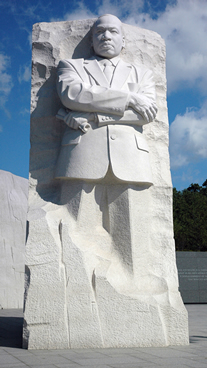
Courtesy of National Park Service
With this faith we will be able to hew out of the mountain of despair a stone of hope. With this faith we will be able to transform the jangling discords of our nation into a beautiful symphony of brotherhood. With this faith we will be able to work together, to pray together, to struggle together, to go to jail together, to stand up for freedom together, knowing that we will be free one day.
—Martin Luther King, Jr. I Have a Dream speech, Lincoln Memorial, August 28, 1963
Between memorials to Abraham Lincoln and Thomas Jefferson stands a new memorial to a man who was never president, but just as profoundly shaped the course of this nation’s history as any elected official. The Martin Luther King, Jr. Memorial commemorates the life of a man who fought for justice in the face of injustice and equality in the face of inequality. His fight, and his faith, expressed through nonviolent resistance, sought to overcome the shadow of slavery and institutionalized racism that still pervaded the United States during the mid-1900s.
The Memorial
Today, visitors to the National Mall will find the Martin Luther King, Jr. Memorial located at the northwest edge of the Tidal Basin, at the intersection of West Basin Drive and Independence Avenue in Washington, DC. The several facets of the memorial each illustrate part of Dr. King’s legacy and life. Entering the memorial from the main entrance at West Basin Drive and Independence Avenue, visitors pass through a plaza that separates the memorial from the hum of the city. Here, a sculpture titled the Mountain of Despair is visible. Visitors can also see this feature clearly from the street. A broken, boulder-like mass that rises out of the ground, the sculpture represents the struggle for equality. The title takes its name from a line in King’s I Have a Dream speech delivered a few steps away at the Lincoln Memorial—"With this faith, we will be able to hew out of the mountain of despair a stone of hope." While facing the Mountain of Despair, the Stone of Hope, whose title also comes from the same speech, is visible pulled forward from the mountain. A 28-foot tall likeness of Martin Luther King, Jr. is carved into the Stone of Hope. Nearby, water features represent the sacrifices of many during the Civil Rights Movement. An Inscription Wall embraces the Mountain of Despair and Stone of Hope featuring quotations from Dr. King.
 |
|
The Mountain of Despair
Courtesy of the National Park Service |
Martin Luther King, Jr.
Born in Atlanta, Georgia in 1929, Martin Luther King, Jr. grew up in a neighborhood that was the center of Atlanta’s African-American community. Eventually, he ministered at the church of his father and grandfather, Ebenezer Baptist Church. The church served as a gathering point for civil rights organizations in the 1960s, including the Southern Christian Leadership Conference. Many sitesassociated with King’s life in Atlanta are included as part of this travel itinerary.
Beyond Atlanta, Dr. King became a leader of the nationwide Civil Rights Movement. Following his graduation from Boston University in 1955, he accepted the call to serve as a pastor at the Dexter Avenue Baptist Church in Montgomery, Alabama. From this position, he helped lead the bus boycott that had started in response to Rosa Parks's act of civil disobedience on a local Montgomery, Alabama bus. A towering leader on the civil rights stage, Dr. King led the August 28, 1963 March on Washington for Jobs and Freedom, where he delivered his famous I Have a Dream speech on the steps of the Lincoln Memorial to a crowd of approximately 200,000 marchers. The Lincoln Memorial is another site in this travel itinerary.
Following the march in Washington, King traveled throughout the United States and the world to rally support for the civil rights movement. His efforts were instrumental in securing the passage of the Civil Rights Act of 1963 and the Voting Rights Act of 1964. For his accomplishments, he was awarded the Nobel Peace Prize in 1964. In 1965, King participated in the Selma to Montgomery (Alabama) marches for voting rights, commemorated today as the Selma to Montgomery National Historic Trail, which is also featured in this travel itinerary. Between 1964 and his assassination in Memphis, Tennessee on April 4, 1968, Dr. King continued to join his voice with others to protest and speak out against inequality.
Martin Luther King, Jr. is honored by this memorial on the National Mall. Flanked by statues and monuments to great political leaders and military campaigns, the monument to King and his nonviolent citizen leadership is a powerful reminder of the ability of individuals to effect change.
The Martin Luther King, Jr. Memorial, a unit of the National Park System, is located at the intersection of West Basin Dr. and Independence Ave. in Washington, DC. The memorial is open 24 hours a day. The memorial bookstore is open 7 days a week from 9:00am to 8:00pm. For more information, including information on the dedication, visit the Martin Luther King, Jr. Memorial website or call 202-426-6841.
The memorial is part of the National Mall and Memorial Parks, which includes the Lincoln Memorial National Memorial, a site featured in this travel itinerary. More information about the Civil Rights Movement may be found in the National Park Service We Shall Overcome: Historic Places of the Civil Rights Movement travel itinerary and on the National Park Service National African-American History website.
Last updated: June 10, 2024
